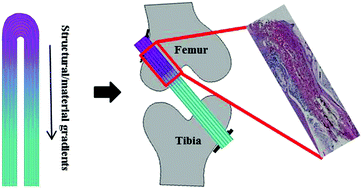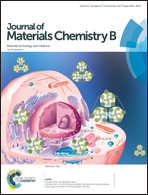Microfiber-reinforced nanofibrous scaffolds with structural and material gradients to mimic ligament-to-bone interface†
Abstract
Most of the existing tissue-engineered scaffolds for the regeneration of anterior cruciate ligament (ACL) are unable to recapitulate the structural/compositional/mechanical gradients at native ACL–bone interface. Herein, we present a unique electrospinning strategy to fabricate microfiber-reinforced nanofibrous scaffolds with structure and composition gradients. The orientations of the electrospun nanofibers gradually change from random to highly aligned, and the contents of nano-hydroxyapatite (nHA) and bone morphogenesis protein (BMP-2) encapsulated into the nanofibers exhibit gradient variation. The gradient nanofibrous scaffolds were found to regulate cellular morphology and zonal bone-specific differentiation in vitro. The incorporation of microfibers significantly improved the mechanical property of the gradient nanofibrous scaffolds, which was similar to native ACL–bone fixation after implantation in vivo. Histological observations revealed that the gradient scaffolds facilitated the formation of fibrocartilage transitional zone at graft and bone attachments that are similar to native ligament-to-bone interface. We envision that the presented method might provide biomimetic physical/chemical/mechanical microenvironments for enhanced multitissue regeneration particularly at the soft-hard tissue interface.



 Please wait while we load your content...
Please wait while we load your content...